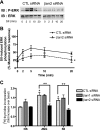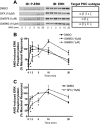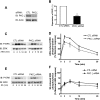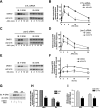Independent beta-arrestin2 and Gq/protein kinase Czeta pathways for ERK stimulated by angiotensin type 1A receptors in vascular smooth muscle cells converge on transactivation of the epidermal growth factor receptor
- PMID: 19254952
- PMCID: PMC2673264
- DOI: 10.1074/jbc.M808176200
Independent beta-arrestin2 and Gq/protein kinase Czeta pathways for ERK stimulated by angiotensin type 1A receptors in vascular smooth muscle cells converge on transactivation of the epidermal growth factor receptor
Abstract
Recent studies in receptor-transfected cell lines have demonstrated that extracellular signal-regulated kinase (ERK) activation by angiotensin type 1A receptor and other G protein-coupled receptors can be mediated by both G protein-dependent and beta-arrestin-dependent mechanisms. However, few studies have explored these mechanisms in primary cultured cells expressing endogenous levels of receptors. Accordingly, here we utilized the beta-arrestin biased agonist for the angiotensin type 1A receptor, SII-angiotensin (SII), and RNA interference techniques to investigate angiotensin II (ANG)-activated beta-arrestin-mediated mitogenic signaling pathways in rat vascular smooth muscle cells. Both ANG and SII induced DNA synthesis via the ERK activation cascade. Even though SII cannot induce calcium influx (G protein activation) after receptor stimulation, it does cause ERK activation, although less robustly than ANG. Activation by both ligands is diminished by depletion of beta-arrestin2 by small interfering RNA, although the effect is more complete with SII. ERK activation at early time points but not later time points is strongly inhibited by those protein kinase C inhibitors that can block protein kinase Czeta. Moreover, ANG- and SII-mediated ERK activation require transactivation of the epidermal growth factor receptor via metalloprotease 2/9 and Src kinase. beta-Arrestin2 facilitates ANG and SII stimulation of Src-mediated phosphorylation of Tyr-845 on the EGFR, a known site for Src phosphorylation. These studies delineate a convergent mechanism by which G protein-dependent and beta-arrestin-dependent pathways can independently mediate ERK-dependent transactivation of the EGFR in vascular smooth muscle cells thus controlling cellular proliferative responses.
Figures







Similar articles
-
{beta}-Arrestin-2 Mediates Anti-apoptotic Signaling through Regulation of BAD Phosphorylation.J Biol Chem. 2009 Mar 27;284(13):8855-65. doi: 10.1074/jbc.M808463200. Epub 2009 Jan 26. J Biol Chem. 2009. PMID: 19171933 Free PMC article.
-
β-Arrestin-mediated Angiotensin II Signaling Controls the Activation of ARF6 Protein and Endocytosis in Migration of Vascular Smooth Muscle Cells.J Biol Chem. 2016 Feb 19;291(8):3967-81. doi: 10.1074/jbc.M115.684357. Epub 2015 Dec 24. J Biol Chem. 2016. PMID: 26703465 Free PMC article.
-
Angiotensin II activates NF-κB through AT1A receptor recruitment of β-arrestin in cultured rat vascular smooth muscle cells.Am J Physiol Cell Physiol. 2013 Jun 15;304(12):C1176-86. doi: 10.1152/ajpcell.00235.2012. Epub 2013 Apr 10. Am J Physiol Cell Physiol. 2013. PMID: 23576578 Free PMC article.
-
Beta-arrestin-mediated signaling in the heart.Circ J. 2008 Nov;72(11):1725-9. doi: 10.1253/circj.cj-08-0734. Epub 2008 Oct 7. Circ J. 2008. PMID: 18838825 Free PMC article. Review.
-
Angiotensin II-mediated vascular smooth muscle cell growth signaling.Braz J Med Biol Res. 2000 Jun;33(6):619-24. doi: 10.1590/s0100-879x2000000600002. Braz J Med Biol Res. 2000. PMID: 10829089 Review.
Cited by
-
β-Arrestin-biased AT1R stimulation promotes cell survival during acute cardiac injury.Am J Physiol Heart Circ Physiol. 2012 Oct 15;303(8):H1001-10. doi: 10.1152/ajpheart.00475.2012. Epub 2012 Aug 10. Am J Physiol Heart Circ Physiol. 2012. PMID: 22886417 Free PMC article.
-
Src is required for mechanical stretch-induced cardiomyocyte hypertrophy through angiotensin II type 1 receptor-dependent β-arrestin2 pathways.PLoS One. 2014 Apr 3;9(4):e92926. doi: 10.1371/journal.pone.0092926. eCollection 2014. PLoS One. 2014. PMID: 24699426 Free PMC article.
-
2021 update on thyroid-associated ophthalmopathy.J Endocrinol Invest. 2022 Feb;45(2):235-259. doi: 10.1007/s40618-021-01663-9. Epub 2021 Aug 20. J Endocrinol Invest. 2022. PMID: 34417736 Free PMC article. Review.
-
Ang-(1-7) is an endogenous β-arrestin-biased agonist of the AT1 receptor with protective action in cardiac hypertrophy.Sci Rep. 2017 Sep 19;7(1):11903. doi: 10.1038/s41598-017-12074-3. Sci Rep. 2017. PMID: 28928410 Free PMC article.
-
Beta-Arrestins and Receptor Signaling in the Vascular Endothelium.Biomolecules. 2020 Dec 23;11(1):9. doi: 10.3390/biom11010009. Biomolecules. 2020. PMID: 33374806 Free PMC article. Review.
References
-
- Drake, M. T., Shenoy, S. K., and Lefkowitz, R. J. (2006) Circ. Res. 99 570–582 - PubMed
-
- DeWire, S. M., Ahn, S., Lefkowitz, R. J., and Shenoy, S. K. (2007) Annu. Rev. Physiol. 69 483–510 - PubMed
-
- Demoliou-Mason, C. D. (1998) Biol. Signals Recept. 7 90–97 - PubMed
-
- Nozawa, Y., Matsuura, N., Miyake, H., Yamada, S., and Kimura, R. (1999) Life Sci. 64 2061–2070 - PubMed
-
- Wassmann, S., and Nickenig, G. (2006) J. Hypertens. 24 S15–S21 - PubMed
Publication types
MeSH terms
Substances
Grants and funding
LinkOut - more resources
Full Text Sources
Molecular Biology Databases
Research Materials
Miscellaneous

